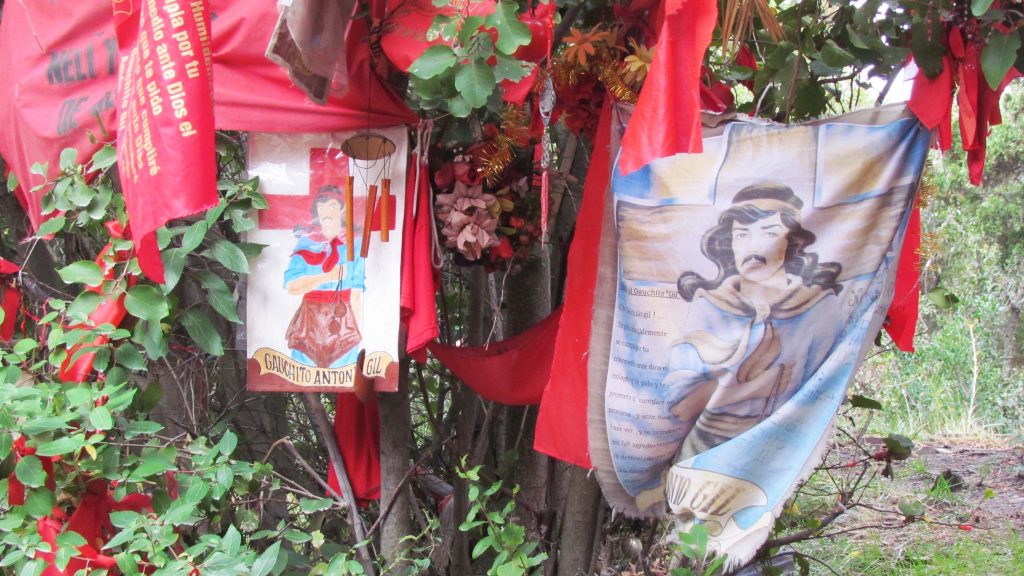As responsible travelers evolve, so do the stories we share.
This article is part of our living archive — trusted content we continue to care for.
First published on May 10, 2016 • Last updated on June 30, 2017.
It was only when we left the big city of Buenos Aires and embarked on a road trip through Southern Argentina that we learned about the Argentine Robin Hood. But the process of learning was a slow one that came step by step along our trail.
Our education began with the red flags that we would see alongside many a highway. At first, we drove by so quickly that we couldn’t exactly tell what we were seeing. But the red flags became a warning to slow down and take a better look. We began to notice that the flags always surrounded a small shrine. Our curiosity was piqued.
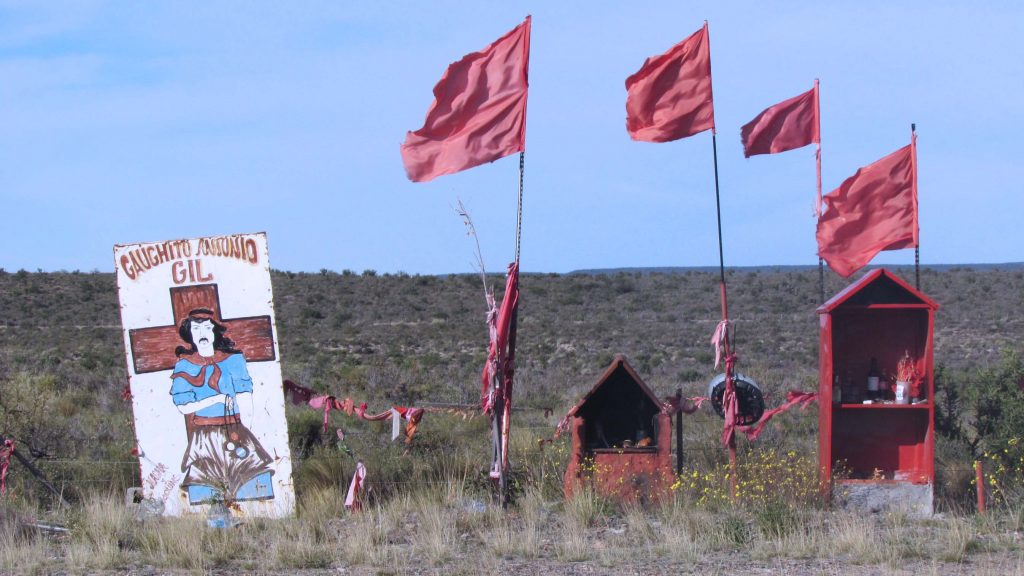
A few days later we saw a shrine with a huge metal sign, slightly rusted and hand painted with a picture of a young man with flowing dark hair, a drooping black mustache, and a shirt the color of the Virgin Mary’s blue cloak. He wore the costume of a gaucho, a leather apron to protect his legs, boleadores to capture the cattle or game, and a red bandana to protect himself from dust and dirt. He stood directly in front of a bright red Christian cross. And we no longer wondered who he was because there was his name, Gauchito Antonio Gil, painted on that very sign.
 We wanted to stop at one of these shrines and take more pictures but the places were always along dangerous stretches of highway where we were afraid to stop for fear of being hit by speeding traffic. However, we finally got lucky. In the mountains near San Martin de los Andes we actually parked our car and walked among the forest of shrines.
We wanted to stop at one of these shrines and take more pictures but the places were always along dangerous stretches of highway where we were afraid to stop for fear of being hit by speeding traffic. However, we finally got lucky. In the mountains near San Martin de los Andes we actually parked our car and walked among the forest of shrines.
Close inspection made us wonder even more about this curious practice. There were bottles of red wine or coca cola, rocks presumably brought from a pilgrim’s home, silk flowers faded by the sun or real ones dried by the wind and weather. And each and every small shrine had the waxy remains of candles that served as a reminder that people stayed to worship and to pray. The burnt matches told us that they came many times.
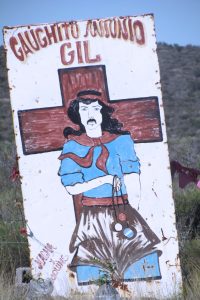 We asked a few questions and people told us that El Gauchito was the Robin Hood of the 1870’s. He stole from the rich, gave to the poor, then died for his crimes. Today, he is worshipped like a saint although the Catholic Church has not sanctified him, thus his appearance in numerous outside venues rather than inside a church or cathedral. The shrines attest to his special place in the hearts of Argentines. After more than a century people pray to this Argentine Robin Hood and leave offerings in hopes that he will answer their prayers or intercede with God on their behalf.
We asked a few questions and people told us that El Gauchito was the Robin Hood of the 1870’s. He stole from the rich, gave to the poor, then died for his crimes. Today, he is worshipped like a saint although the Catholic Church has not sanctified him, thus his appearance in numerous outside venues rather than inside a church or cathedral. The shrines attest to his special place in the hearts of Argentines. After more than a century people pray to this Argentine Robin Hood and leave offerings in hopes that he will answer their prayers or intercede with God on their behalf.
After our trip, I wanted to know more about Gauchito Gil and found a wonderful article written by Francesca Fiorentini for the Argentina Independent. She tells a story of a young Gaucho named Antonio Mamerto Gil Nuñez who falls in love with the wrong girl. She just happens to be married to the local chief of police. To stay out of trouble, Gil leaves town to fight with the Triple Alliance in Paraguay.
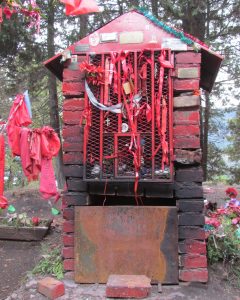 When he returns, he finds another war waiting for him, a civil war. But he has a dream where the native Guaraní god Ñandeyara tells him “not to shed the blood of brothers”. Gil becomes a deserter and dedicates his life to stealing from the rich to help the poor. Of course, the police chief finds him and rather than wait for a trial, condemns and kills Gil but not before our Robin Hood gives warning
When he returns, he finds another war waiting for him, a civil war. But he has a dream where the native Guaraní god Ñandeyara tells him “not to shed the blood of brothers”. Gil becomes a deserter and dedicates his life to stealing from the rich to help the poor. Of course, the police chief finds him and rather than wait for a trial, condemns and kills Gil but not before our Robin Hood gives warning
“You are going to kill me now, but you will arrive in Mercedes tonight at the same time as a letter of my pardon. In the letter they will also tell you that your son is dying of a strange illness. Invoke me before God and pray for your son’s life, because the blood of the innocent serves to makes miracles.”
The police chief returns home to find both his son sick and a letter of pardon waiting. He takes his ill son to the grave of Gauchito Gil and prays for his intervention with God. Miraculously, the next day his son is cured.
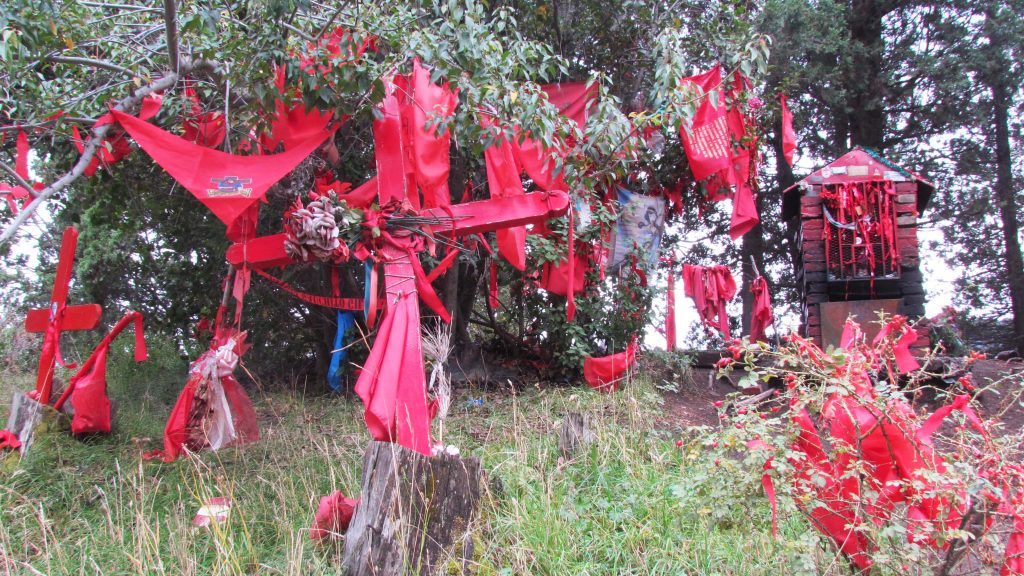
Like many South America legends, that of Gauchito Gil blends native mythology with Catholic belief in an attempt to help merge two distinct cultures.
The Catholic Church will never declare Gauchito Gil a saint. But no matter. In the hearts and minds of Argentines, El Gauchito lives on.


